The Stromer ST3 Pinion is a S-pedelec with a 9-speed pinion gearbox and a Syno Drive II rear wheel motor. In this review I will talk through all the ins-and-outs if you are planning to buy a new electric bike for commuting or cycling trips or even a camping holiday. Watch the video review!
- Price: € 9308,-. (from € 7290,-)
- Weight: 32,8 kg
- Size: frame size M
This is not the first Stromer ST3 that I am reviewing. Two years ago I reviewed the ST3 with a different gear mechanism so that’s the reason I tested the Stromer again. But there is one other reason: the Stromer has an ABS braking system! Let’s crack on.
Swiss brand
For those who are new to Stromer, let me be so polite to introduce the brand to you. Stromer is a company that is based in Switzerland. They started designing bikes around 2007 and the first bikes rolled out of the factory in 2009 on to the Swiss market. The philosophy of Stromer founder Thomas Binggeli was that he wanted to design bikes that would get commuters out of their car and onto a bike. A Stromer bike of course.
The idea of convincing car commuters to become bike commuters is a pretty logical one. A lot of people travel only short distances by fossil car to the office. Yes, they change now to electric cars and sometimes to electric bikes. It is a nice way of getting our world a bit greener. I am not getting into the discussion on how green electric cars and bikes are since I don’t have the answer. I do question the sustainability of battery packs at the end of life stadium though. Now let’s get back to the Stromer ST3.
Stromer ST3 Pinion frame and fork
The heart of the Stromer ST3 Pinion is a very big oversized rather boxy aluminium frame. The big beefy downtube houses the enormous battery. The whole left side of the downtube – with the black rim around it – opens so you can take out the battery. Looking from the side the top tube is of a more modest size but from above is still pretty wide with a reason: it houses the touchscreen that operates the bike. On the left of the top tube is the connector for the charging system and on the right there is a button that releases the battery. Underneath the top tube close and just behind the head tube you’ll find the on/off button. Like the frame the fork is made of aluminium too.
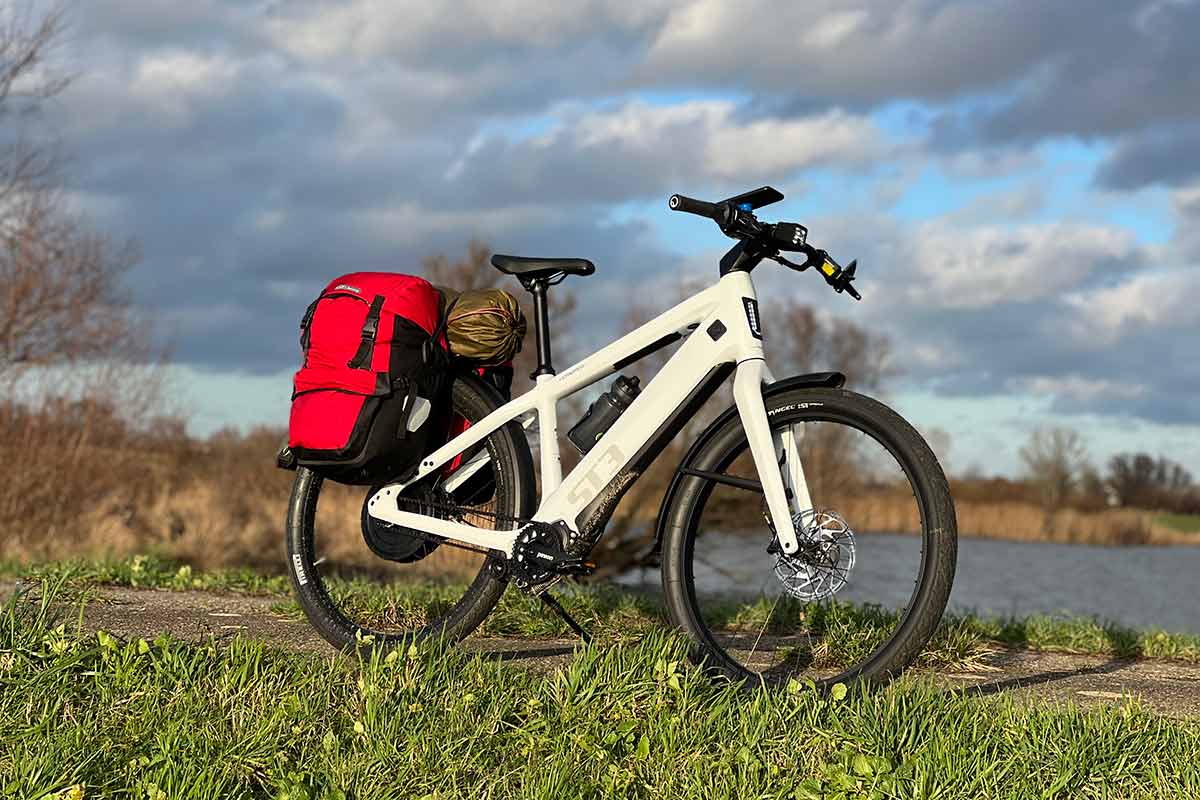
Size and weight
The bike that I am reviewing is a size medium in the Sport version. Size M is also the smallest frame size available and should work for everybody from 1.78 cm and down. I am 169 cm. The M is fine and I don’t have the feeling the bike is too big for me. The Sport version frame differs from the Comfort frame where the top tube and the seat are lower for getting on and off the bike more easily. Back to the one that I am reviewing. The seat tube is 432 mm, the top tube 548 mm and the down tube is 710 mm. The Stromer ST3 is also available in a size L (175 cm-188 cm) and XL (185+ cm).
For the full sizing specs just follow this link.

Like I wrote in the past: Stromer – regrettably – does not state the weight of their bikes so I hung it on my scale and I measured a weight of 32.8 kg This is the complete bike with pedals and the accessories I added: an aluminium bottle cage and an Quad Lock mount for my iPhone. If you are planning to buy a bike, you should always be aware of the maximum load limit. The ST3 is rated for 150 kg maximum. This is bike, luggage and rider. So if you are more than 117,2 kg consult Stromer about this.
Rear wheel motor
The Stromer ST3 Pinion has a motor that is positioned in the rear wheel. The motor is a Syno Drive II and has a claimed power output of 820 Watt, a torque of 44 Nm and a maximum speed up to 45 km/h. For the US it is a bit different and Stromer claims 600 Watt and Class 3 with a speed up to 28 mph. Since the motor is a rear-wheel mounted one, the chain stays and the seat stays of the frame are constructed accordingly: Chunky like the rest of the frame.
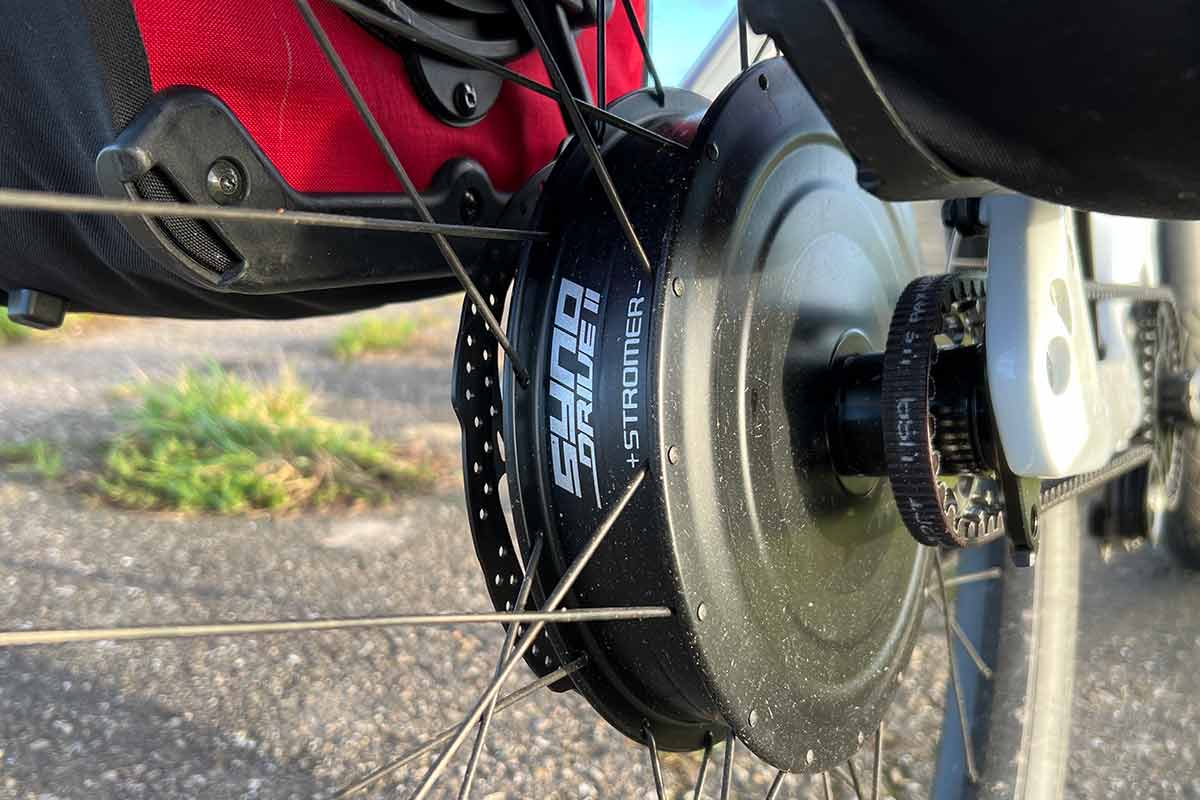
814 Wh or 983 Wh battery
So far this bike is very similar to the ST3 I tested two years ago. Talking about the battery there is one little difference. This one comes standard with a 814 Wh battery but with an estimated range of over 211 KM in the screen of this ST3, I suspected that this bike is equipped with the 983 Wh battery and that is indeed the case.
Two years ago it was also possible to order a ST3 with the smaller and less expensive 500 Wh battery which was fine if you only travel shorter distances when commuting. That 500 Wh battery is history. Now you have the choice between a 814 Wh battery that gives a range of maximum 150 km (90 miles) according to Stromer. In my case Stromer promises a range of 180 km (110 miles) with the 983 Wh battery. A bit silly is the fact that it is possible to buy a separate 618 Wh battery with a range of 120 km (75 miles) as an accessory to replace an empty battery for example. It would sense to make this a default choice. More on range later.
Test circumstances
Testing this Stromer ST3 Pinion does bring a lot of memories back to two years ago. I got the bike in December and – again – it proved not to be the best periode weather-wise. December was with an average of 3,9 degrees Celsius even worse than two years ago. January was pretty chilly too but also very rainy and with a lot of wind. Weather and especially temperature influence battery life, hence these remarks. It might not be the most appealing weather to go biking but it is super for testing gear and bikes. With a bike one discovers pretty fast how stable the ride is and the range of the battery in poor circumstances.
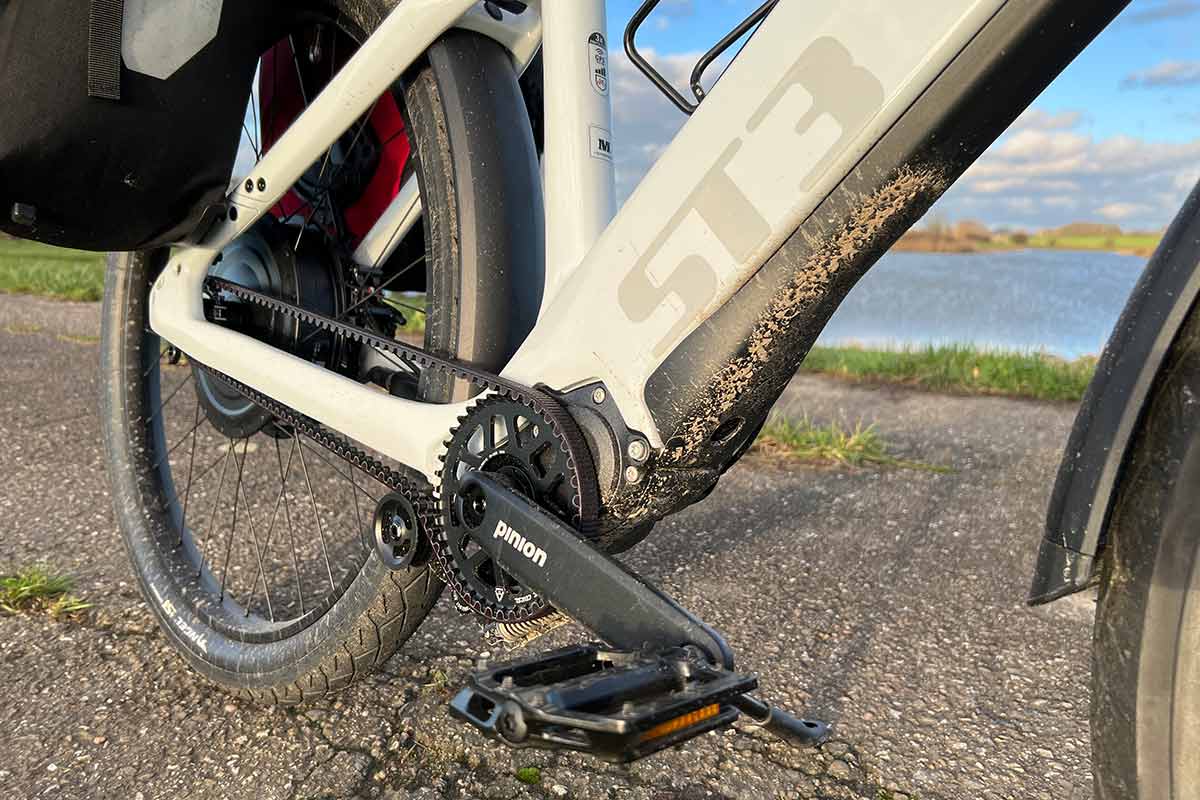
The E-system
Firing up the ST3 is easy: press the rubbery button below the top tube and the system starts. Enter the pin code on the touchscreen and you are good to go. The touch screen is also used to change the bike’s settings. The menus are pretty easy to understand and changing settings is mostly done by shifting sliders and touching virtual buttons. Watch the video! The screen itself is even in bright sunlight, easy to read and switches automatically from day- to night mode. The ST3 has a sim card on board so when it is on, it is connected to the internet. The good thing about this is that updating the system is easy. When new firmware is available you get notified. Because of this the ST3 can be connected to the Stromer OMNI app that is available for iOS and Android.
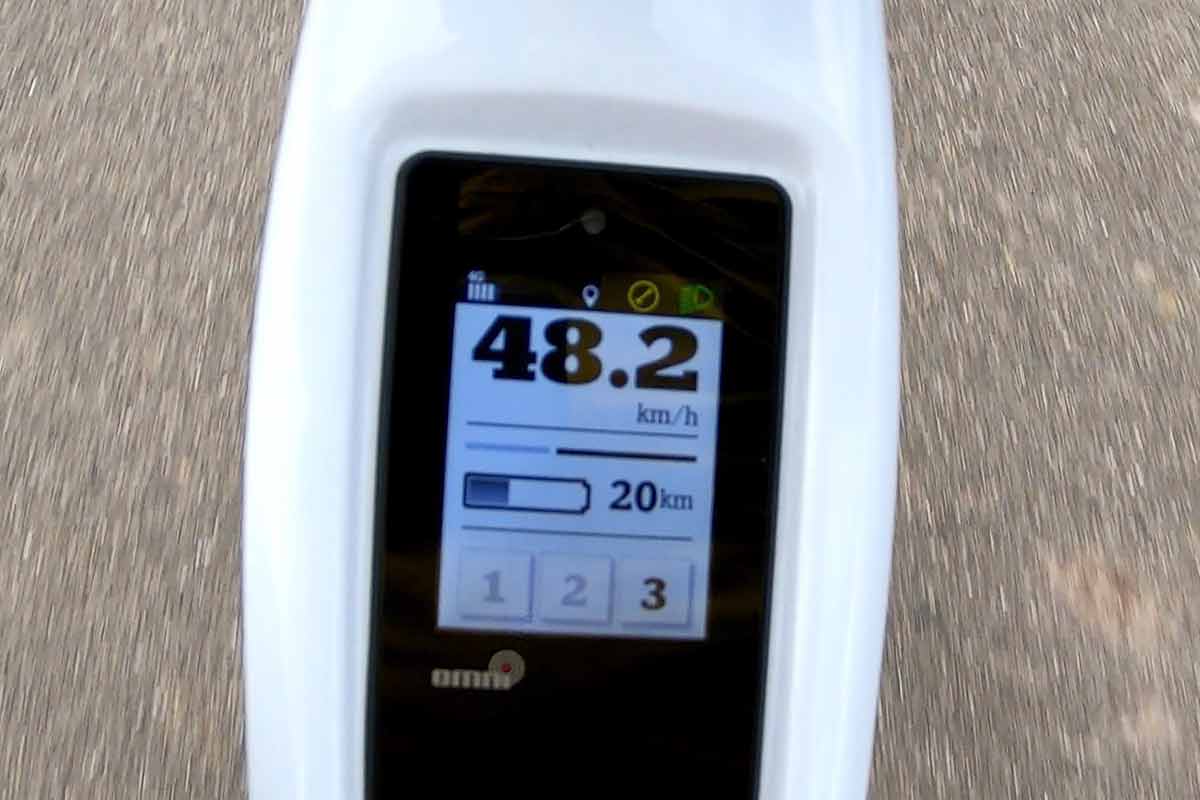
The Stomer OMNI app
The Stromer OMNI app is a friendly one but doubles quite a lot with the info on the screen of the bike. The App gives information about battery status, travel distance, average speed, time, temperature (outside and battery) etc. It can also be used to change the settings of the bike but again: it doubles more than giving something extra or new. The app shows a google map and you can report your bike as stolen. I’ll get back to the app later.
Support modes
After awakening the system, biking is just like biking on any bike. Put force on the pedals and start cycling. If you get on the bike for the first time take a peek at the screen on the top tube. There you’ll find the support modes: 1, 2 or 3. Start in 1 or 2 the first time. Three is maximum support and draining the battery while 1 is the energy friendly long lasting mode. Next to that…. Starting the ride in 3 feels like being on a Nimbus 2000*: the acceleration is immediate and fast.
Changing between the different support modes is done with a + and – button on the left side of the handlebar. The buttons work perfectly also when gloved up. Positioned next to the +/- button is a button for the bell. On the previous ST3 that bell was an electronic horn that was really loud; I scared the crap out of pedestrians once in a while. Regrettably Stromer did something about it and now the bell is a silly high pitched computer sound that nobody seems to hear or understand. Every time I went out with the bike I had to slow down a lot and ask people kindly to get out of the way. This needs to be changed.
*See one of the Harry Potter movies

Pinion C1.9 gearbox
The biggest change on the Stromer ST3 Pinion is of course the Pinion 9-speed gearbox that is positioned in the heart of the frame. Pinion has been on the market since 2011 and is a trusted and reliable gearbox for mountain bikes, travel bikes and commuter E-bikes and S-pedelec bikes. The Pinion gearbox can best be compared to the manual transmission or gearbox of a car. It is built around two axles with gears and a twist grip on the right handlebar to select the desired gear. In addition to the 9-speed, Pinon also makes a 6- 12- and 18-speed version. The reach of the C1.9 is 568% and the steps between gears is a fixed 24,3%. If you want to know more, read this article I made on Pinion gearboxes. Shifting gears is a dream, but beware not to put (too much) pressure on the pedals when shifting; the Pinion does not like this.
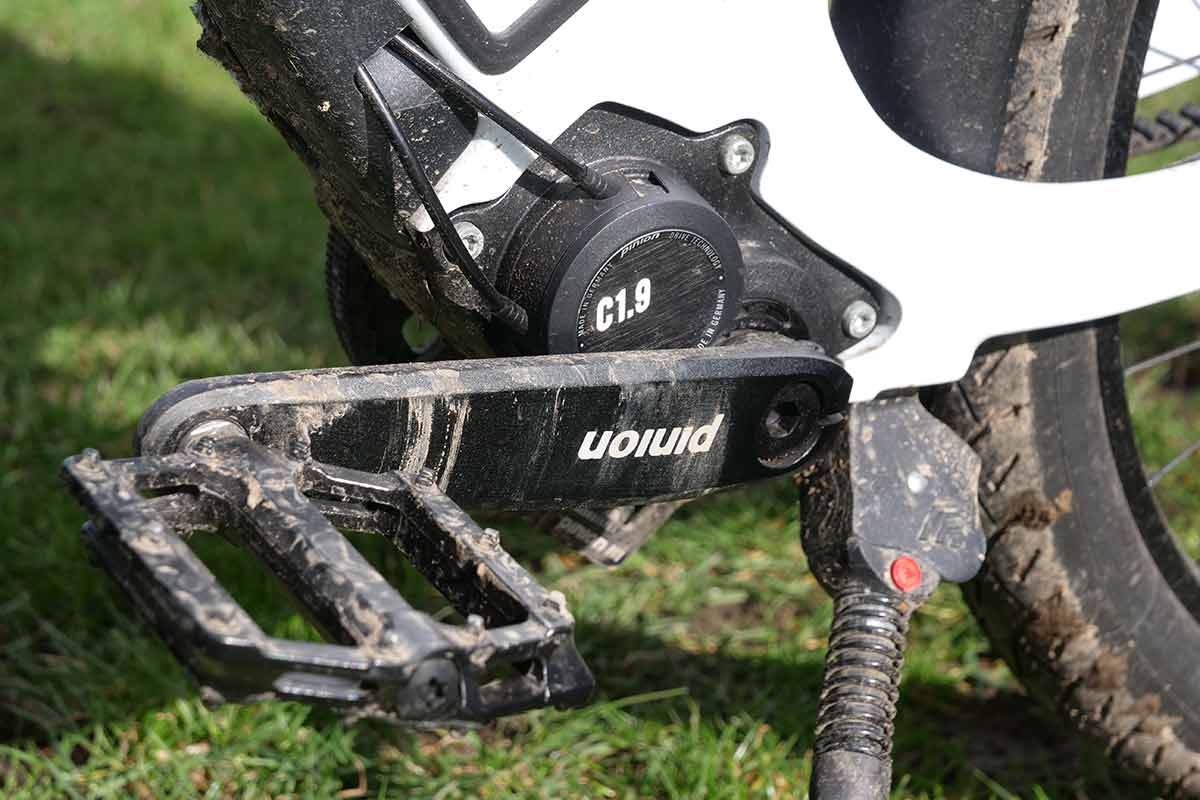
Gates Carbon Belt Drive
The connection between the Pinion and the Syno Drive II motor is done with a Gates Carbon Belt Drive. As far as I’m concerned, a belt is the right choice: it’s low-maintenance and quiet. To mount the belt – and unlike a chain, a belt is one piece – there is an opening in the right seat stay. This gap is filled by a solid plate where the screw thread is in the plate itself and not in the frame. It is a very stiff construction not compromising the stiffness of the bike at all. To keep the belt tensioned a tensioner is positioned near the front sprocket.
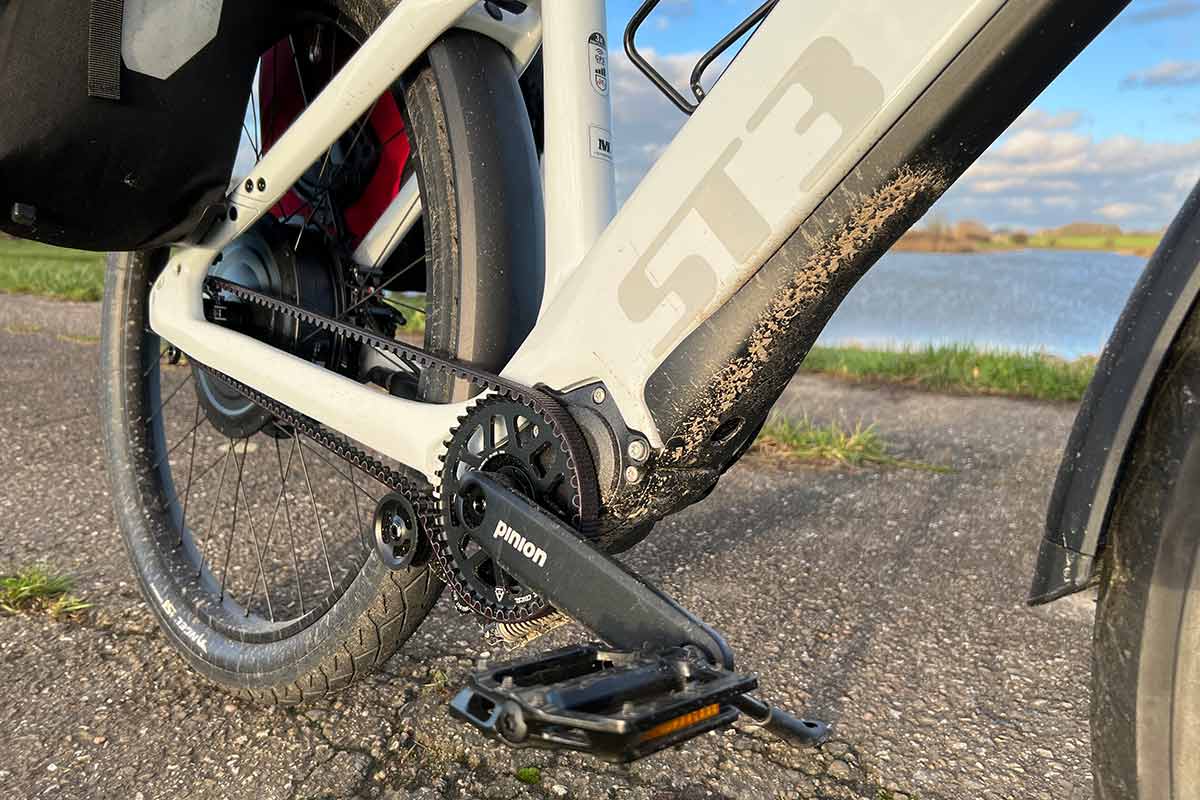
Battery life
Battery life is important. I did my best to drain the battery as fast as I could. This means maximum support from battery and motor: support mode 3 and riding as much 45 km/h as I could. With the harsh weather conditions during testing, I ended up with an average of around 65-70 km on a full charge. At first I found this ridiculous. I expected at least 100 or even 120 km. Then I started realising that the promised 180 km range is of course not how I thought it would be: 45 km/h in support mode 3 lasting 180 km on flat terrain with no wind and an average outside temperature of 20 degrees Celsius. Stop dreaming Gijs! 180 km is on the flat with no wind doing 20-25 km/h in support mode 1. So the advertised range on the Stromer website could and should be a bit more clear on this. It definitely is not. One time I ran out of juice and I still had to do 7 km with wind up front; not nice!
My advice
Remains the questions: is a range of 65-70 km good or bad and am I still disappointed or not. Well, I came to the conclusion that the range in mode 3 of 65-70 km is fine. Especially since I tested in poor non battery friendly conditions. For most commuters – the main purpose of the bike – 70 km commuting a day is the max on what they would probably do with a bike. With a longer distance a car would be more sensible. On holiday there is absolutely no point in biking this fast since you would reach your destination in a few hours, not the idea of a biking holiday. Just use support mode 1 if you have all day and number 2 if you want a bit more support. On a daily basis I would go in 2 because it is a nice balance between support, exercising, energy-consumption and the feeling of riding a beautiful fast bike. It also looks a bit silly doing 20-25 km/h on a speed-pedelec.

Note: Recharging the 983 Wh battery takes about 5 hours and 45 minutes. I measured it and Stromer claims 15 minutes less. Probably a temperature difference. I noticed that the temperature is a big factor. Keeping the bike in the shed at an outside temperature of 6 degrees I had a charge of 34%. Then I took it into the living room overnight with a temperature of 18 degrees and in the morning the battery was 46% (without extra charging).
Carriers and luggage
As mentioned above: I see the Stromer ST3 Pinion not only as a commuter bike but also as a travel bike. In that respect I like the fact that Stromer equips the ST3 with a decent rear carrier. The carrier is rated for 22,5 kg and that is fine for lightweight bike travel. I always review trekking bikes with two rear panniers filled with 15 kg in total and a tent and sleeping bag in the middle. For me this is more than enough gear to bring on a trip.
The small slim carrier is connected to the frame and the very sturdy aluminium rear fender. The combination feels very solid; even when changing the weight in fast followup corners. Panniers, carrier and bike feel like one solid piece and that is how it’s supposed to be. Funny thing is that the side stand – a Pletscher – is rated at only 40 kg max. With the ST3 weight of almost 33 kg theoretically only 7 kg remains to be put on the bike. This is fine for commuting with one pannier and a laptop in it, but for travelling this is just too little. In theory, that is.

Disc brakes with ABS
The Stromer is equipped with 203 mm discs in the front and rear and the front brake has a four piston calliper and the rear a two piston one. The brake levers are Stromer HD492’s and they are – like the whole brake system – developed together with American brake manufacturer TRP. The ST3 that I am reviewing has an extra: ABS or anti-lock braking system.
With the previous ST3 I already wrote that the stopping of the brakes is enormous. Using the front brake on slippery surfaces needs some experimenting in finding the right moment of maximum brake power and a wheel that locks. Doing this with 45 km/h takes guts. In case of an emergency stop a mistake is made easily. The ABS prevents this.
The ABS system is only on the front brake. This is logical since the front brake has the most stopping power. When I start riding a yellow icon appears on screen that the ABS-system is there and when the speed is over 5 km/h this icon disappears. This means: all is well, system active and working! If the icon stays on the brake still works but the anti-locking system does not. Go see your dealer. Read on!
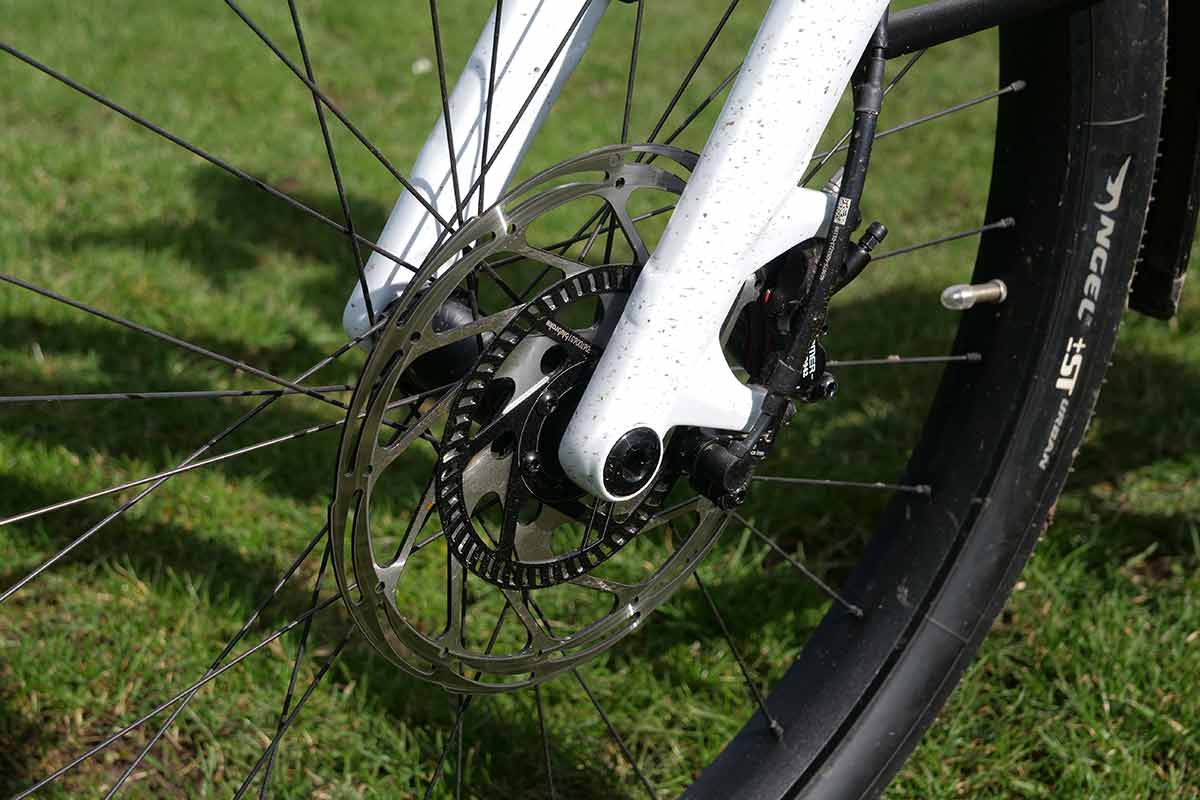
Braking with the ABS is insuring. Apply the brake levers – they have a nice feel to them and the reach of the lever is adjustable – and the balance of braking on flat smooth dry tarmac is very nice and sometimes overwhelming. Yes, the ABS works but on dry tarmac that is not very needed. On wet slippery autumn and winter roads the ABS front brake proves its purpose. Braking hard does activate the anti-lock brake system and the front wheel does not lock up resulting in a very confident feeling.
ABS Failure
On one of the last days just before wrapping up this article, I was testing the minimum brake distance on very nice dry bit salty tarmac. Run one with 25 km/h went super: and the ABS worked. Run two with 35 km/h… the rear wheel came about 0.5 metre in the air. The ABS failed. I had a career in the past as a motorcycle test rider for a motorcycle magazine and we did a lot of experimenting with brakes and stoppies. I am happy I did this because I had full control on the Stromer ST3 Pinion and all went well.
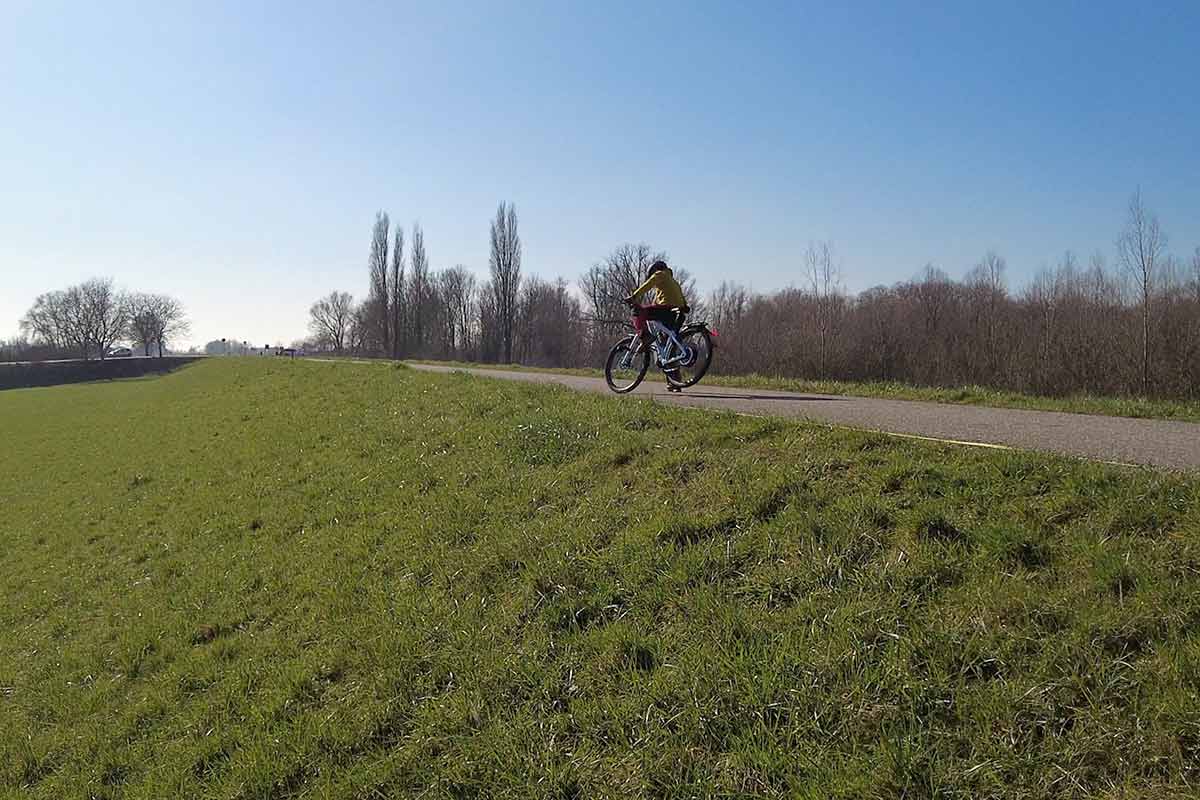
To see what the problem was, I went to the Stromer centre in The Netherlands that is quite close to where I live. After updating the bikes firmware and a lot of testing on the electrical system we concluded it must be a blown fuse. We took the bike apart to get to a fuse that is positioned in the heart of the frame close to the motor; it was blown. We replaced it and the system works fine again. Why did the fuse blow? I and Stromer have no clue; bad luck. Just for the record… With the previous ST3 I had to visit a dealer because of an energy failure and with the introduction of the ST7 last year in Antwerp, Belgium I had a failing on the ABS system too. Btw it would make sense that a dealer could ‘read’ the bikes system from a distance. It is connected to the internet, it has the app so it should not be needed to go to a dealer to see what a failure is. Going to the dealer to get it fixed: yes, for sure.
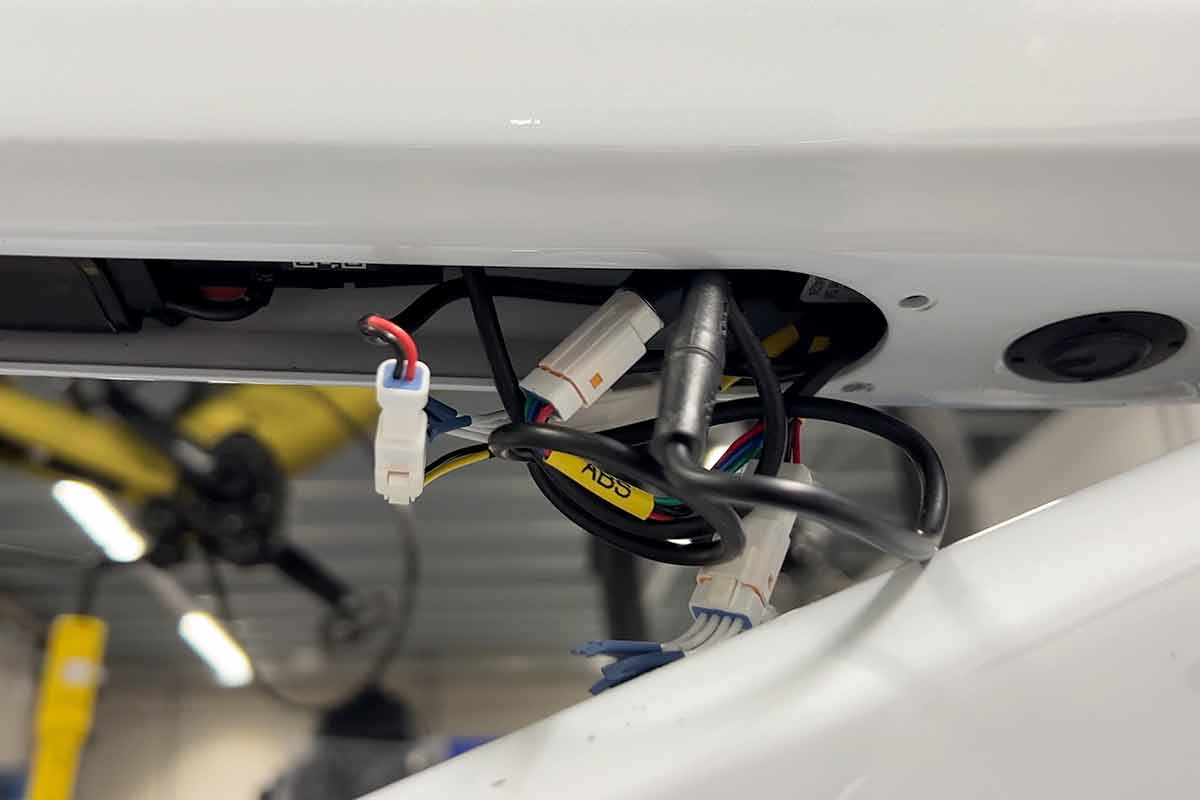
Regenerative braking
One cool feature of the brake system is that sensors are built in the brake levers. Btw: They fit my small hands and will fit large hands too. As soon as you start braking the motor stops delivering power and since it is a rear wheel motor it helps braking. This saves brake-pads and in mountainous areas this should be noticeable. Another cool thing is – and this is what Stromer tells me and I could not test in our flat country – that going downhill for longer distances the motor brakes and generates power to feed the battery. They claim this regenerative braking gives an extra range up to 20%. But again: I could not test this.
Stromer ST3 Pinion Lights
When braking I not only cancel the operation of the motor but I also activate the brake light. The rear light is a Roxim R3E and it is very visible from a big distance and the brake light is even extra bright. The headlight is a Roxim Z4E Pro and can be operated with a switch on the same unit as the +/- button. It has a low beam of 600 lumen and a high beam of 900 lumen. Both have proven to be excellent. A third light is a running light on the head tube. The lights are always on and can not be turned off. A matter of safety.
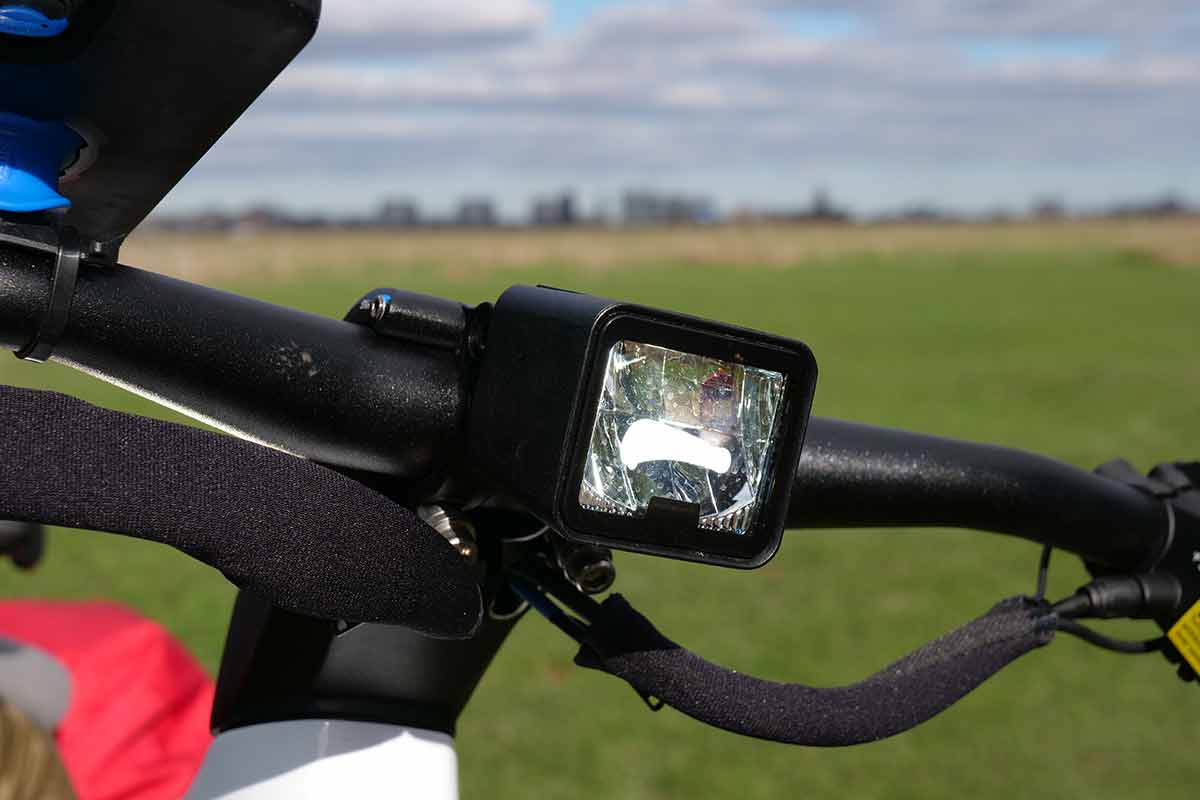
Riding position
The riding position on the Stromer ST3 Pinion is a comfortable one. It is a bit sporty, but still the weight of the rider is well distributed through the saddle and handlebar. One thing that surprised me is that – when I was setting the bike up to my physical measurements – the seat post had to be extended to the full max. Although the bike and the geometry feels very comfortable, during riding I still had the feeling that the seat post – I have a 30 cm one – could be a bit higher for more comfort. A longer seat post is available from Stromer.
The saddle is a Selle Royal VIVO and I found it very comfortable. The same for the Ergon custom GA30 Single Twist Shift grips. The handlebar is 690 mm wide and has a very sweet slightly curved shape. The position of the handlebar can not be changed in the vertical direction; the stem does not have any adjustment in this manner. The handlebar can be tilted a bit though. On the left side of the handlebar is a mirror that gives an excellent view on what’s behind. Be aware: together with the excellent mirror the handlebar width is 830 mm.
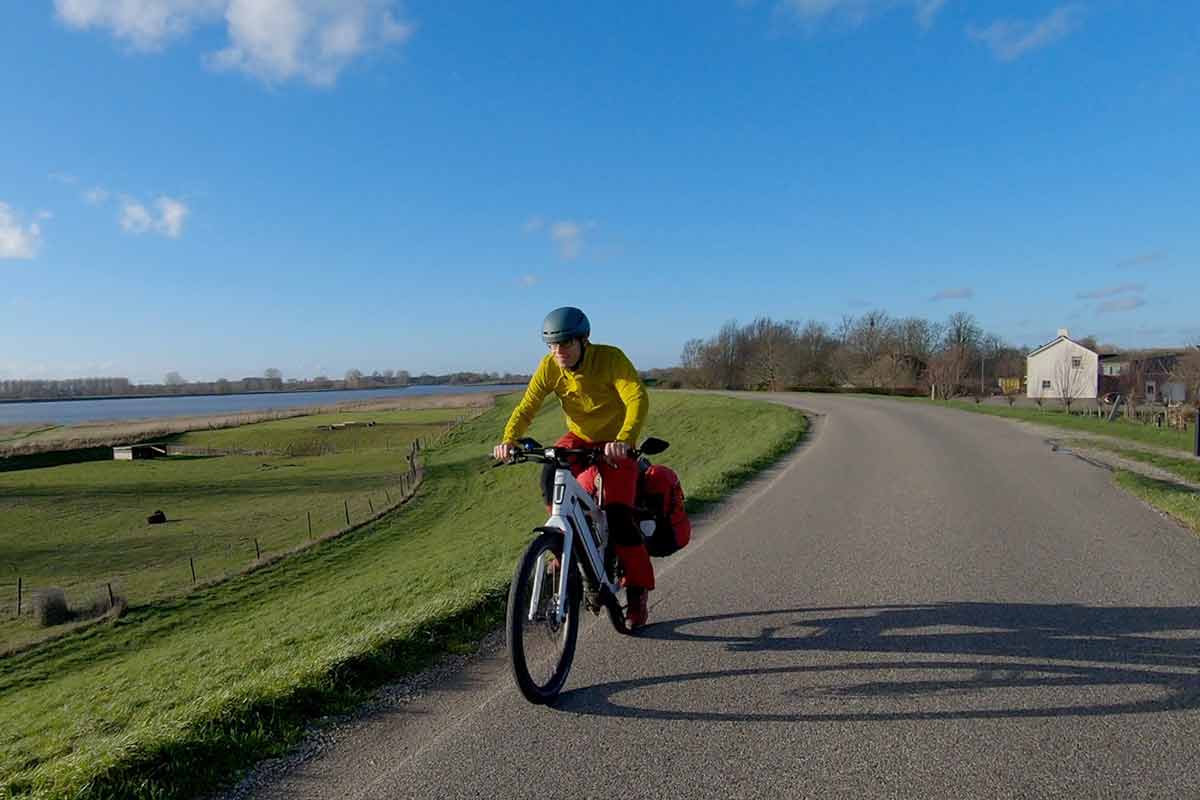
Riding comfort
As mentioned above: frame and fork are made of aluminium. Both are extremely stiff. This is good since it makes the ST3 handle very predictable. But the stiffness also has a downside. The bike is very sensible to minor hubs and bumps in the road. Riding on fresh smooth tarmac is a dream but as soon as the tarmac is a bit worn out or – worse – tree roots are under the tarmac the bike feels pretty hard.
On roads that are paved with bricks – we have a lot of them – riding can be uncomfortable from time to time. A bit less pressure in the new 27.5’’ Pirelli Angel ST Urban tires help. One thing that did not change: Because the weight of the battery in front of the crank, the weight of the Pinion low in the middle and the motor way to the back, the ST3 is very well balanced.
Stromer Bike Configurator
The Stromer that I am testing is not a standard test bike and the Stromer Bike Configurator is a nice online tool to figure out what your Stromer is going to cost. The ST3 price starts from € 7290,- with a derailleur and a chain. The pinion version is an option and you will need to pay € 828,- extra for this. Also the big battery and the ABS are optional. The battery upgrade from 814 Wh to 983 Wh costs € 340,- and the ABS will set you back another € 850,-. For a bit more comfort you can add an upside-down suspension fork – that is an extra € 990,- and a suspension seat post that costs € 245,-. The bike as I am reviewing retails for € 9308,-. With the suspension fork and seat post the bike is in total € 10.543,-. Just for the record: an extra 983Wh spare battery costs € 1990,-.
Safety & OMNI App & Range
As promised I would get back on the Stromer OMNI App. There is one thing I don’t get on this Swiss bike: the position of the screen in the top tube. I wrote this in my previous review and I will write it again: I want to travel safely and with a speedometer between my legs this is not the case. I don’t see it when I am paying attention to the road ahead; at 45 km/h looking down is not an option. I don’t even understand that this construction is legally possible, but apparently it is.
The solution could be the Stromer OMNI app. Stromer has a nice system – comes with the bike – to mount a phone on the stem. If the app would have something like a dashboard with a speedometer that would solve this partly. Running out of phone battery power is not a problem since there is an usb-connector in the front of the head tube. Although I don’t really like the execution of it since I don’t think this is a 100% waterproof construction. With this bike there should be a wireless charging system in the stem. And another improvement would be a range prediction that works with a map in the app so you know how long you can ride before the ST3 runs out of power. A distance prediction without the map is on the screen of the Stromer though.
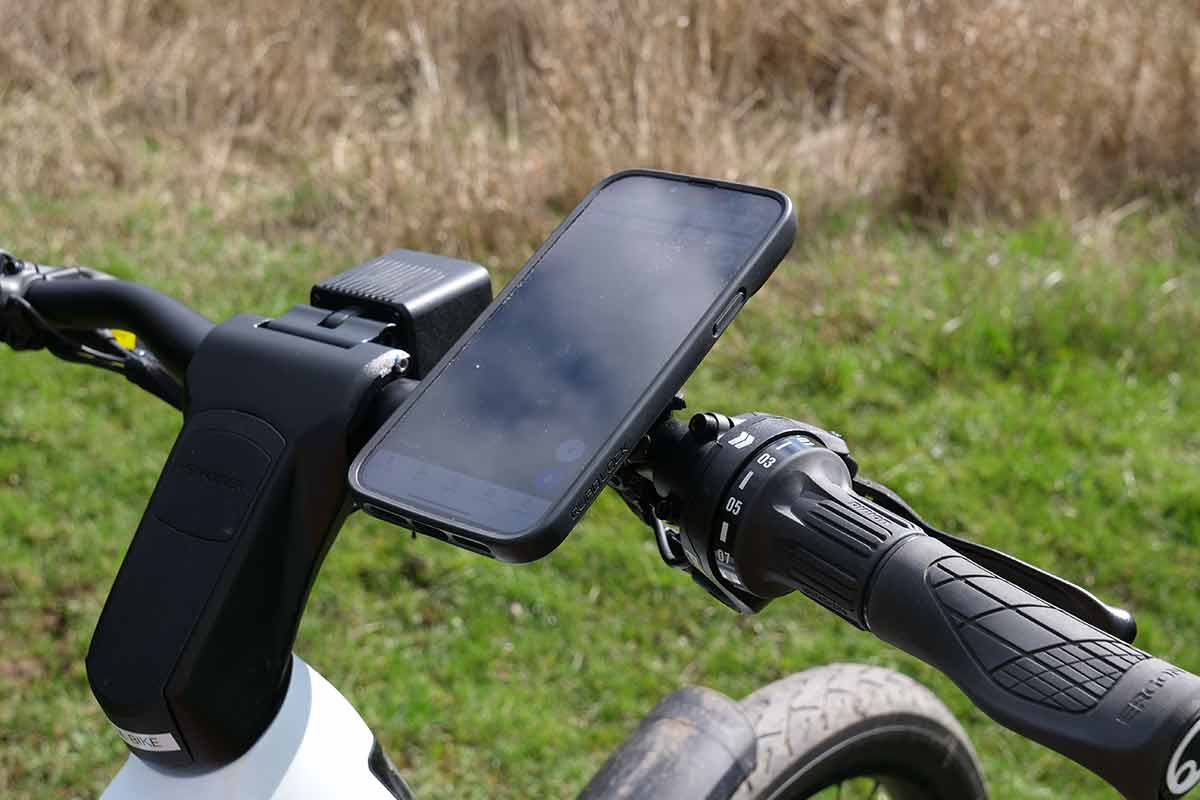
My verdict
The Stromer ST3 Pinion is a very nice speed-pedelec. I liked the ‘normal’ ST3 already and with the Gates Carbon Belt Driven and the 9-speed Pinion the bike only got better. Power delivery is very smooth and almost noiseless. Shifting is swift once you get used to not putting too much force on the paddles when shifting. The reach of 568% is super. The ride is stable, predictable and comfortable on tarmac. It’s less forgiving on uneven surfaces.
A range of 65-70 km/h in maximum support is fine for commuting and the other support modes work for relaxed holiday trips. The carrier is stable in carrying two full panniers and some more stuff in a duffel between them.
The brakes are top notch and the addition of ABS on the front suits the bike and increases its safety. If it works.
I love the lights: the front is very bright and the rear light is visible from a great distance. The brake light is no luxury. I like the running light in the stem. I don’t feel comfortable with the screen in the top tube between my legs; it should be in front of the rider. The fact that the OMNI app does not cover this together with a range prediction that works with an active map, is silly for a bike like this.
The price of the Stromer ST3 Pinion with ABS is € 9308,- and that is a lot of money for a speed-pedelec that still has some flaws. The ABS system on only the front brake is in my opinion too expensive and does not add that much if you know how to brake. Because of the super Pinion I rate the Stromer ST3 Pinion a bit higher than ST3 without: at 8.8 out of 10 points total.
Information
International: www.stromerbike.com
The Netherlands and Belgium: www.stromerbike.com/nl
US & UK: www.stromerbike.com/en
